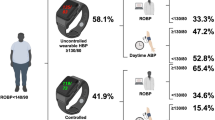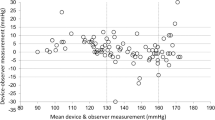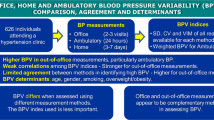Abstract
Several studies compared blood pressure (BP) at home (HBP) with ambulatory BP (ABP), but using different devices, which contribute to differences in measured BP. A novel dual-mode device allowing ABP and HBP monitoring (Microlife WatchBPO3) was validated according to the European Society of Hypertension International Protocol and used to compare the two methods. In the validation study, 33 subjects were assessed with simultaneous BP measurements taken by 2 observers (connected mercury sphygmomanometers) 4 times, sequentially with 3 measurements taken using the tested device. Absolute observer-device BP differences were classified within 5/10/15 mm Hg zones. Measurements with ⩽5 mm Hg difference were calculated per participant. In the validation study, the device produced 70/89/96 measurements within 5/10/15 mm Hg, respectively, for systolic BP and 67/95/99 for diastolic BP. Twenty-eight subjects had at least two of their systolic BP differences ⩽5 mm Hg and one subject had no difference ⩽5 mm Hg, whereas for diastolic BP, it was 22 and 1 subjects, respectively. Mean device-observers BP difference was −0.3±5.6/−2.4±4.8 mm Hg (systolic/diastolic). In the application study, the difference between daytime ABP and HBP was 0.5±7.9 mm Hg for systolic BP (mean±standard deviation, 95% confidence intervals (CI) −1.9, 2.9, P=NS) and 0.6±5.5 for diastolic BP (95% CI −1.1, 2.3, P=NS). In conclusion, the Microlife WatchBPO3 device for ABP and HBP monitoring fulfils the International Protocol validation criteria. Using this device, no clinically important difference between daytime ABP and HBP was detected. These data justify the use of the same diagnostic threshold for both methods.
This is a preview of subscription content, access via your institution
Access options
Subscribe to this journal
Receive 12 digital issues and online access to articles
$119.00 per year
only $9.92 per issue
Buy this article
- Purchase on Springer Link
- Instant access to full article PDF
Prices may be subject to local taxes which are calculated during checkout


Similar content being viewed by others
References
O'Brien E, Asmar R, Beilin L, Imai Y, Mancia G, Mengden T, et al., on behalf of the European Society of Hypertension Working Group on Blood Pressure Monitoring. European society of hypertension recommendations for conventional, ambulatory and home blood pressure measurement. J Hypertens 2003; 21: 821–848.
Parati G, Stergiou GS, Asmar R, Bilo G, de Leeuw P, Imai Y, et al., on behalf of the ESH Working Group on Blood Pressure Monitoring. European society of hypertension guidelines for blood pressure monitoring at home: a summary report of the second international consensus conference on home blood pressure monitoring. J Hypertens 2008; 26: 1505–1526.
Pickering TG, Miller NH, Ogedegbe G, Krakoff LR, Artinian NT, Goff D . Call to action on use and reimbursement for home blood pressure monitoring: a joint scientific statement from the American Heart Association, American Society of Hypertension, and preventive cardiovascular nurses association. Hypertension 2008; 52: 10–29.
Stergiou GS, Skeva II, Zourbaki AS, Mountokalakis TD . Self-monitoring of blood pressure at home: how many measurements are needed? J Hypertens 1998; 16: 725–731.
Stergiou GS, Skeva II, Baibas NM, Kalkana CB, Roussias LG, Mountokalakis TD . Diagnosis of hypertension using home or ambulatory blood pressure monitoring: comparison with the conventional strategy based on repeated clinic blood pressure measurements. J Hypertens 2000; 18: 1745–1751.
Stergiou GS, Efstathiou SP, Argyraki CK, Roussias LG, Mountokalakis TD . White coat effect in treated versus untreated hypertensive individuals: a case-control study using ambulatory and home blood pressure monitoring. Am J Hypertens 2004; 17: 124–128.
Bayó J, Cos FX, Roca C, Dalfó A, Martín-Baranera MM, Albert B . Home blood pressure self-monitoring: diagnostic performance in white-coat hypertension. Blood Press Monit 2006; 11: 47–52.
Verberk WJ, Kroon AA, Lenders JW, Kessels AG, van Montfrans GA, Smit AJ et al. Home versus office measurement, reduction of unnecessary treatment study investigators. Self-measurement of blood pressure at home reduces the need for antihypertensive drugs: a randomized, controlled trial. Hypertension 2007; 50: 1019–1025.
Mancia G, Sega R, Bravi C, De Venuto G, Valagussa F, Cesana G et al. Ambulatory blood pressure normality: results from the PAMELA study. J Hypertens 1995; 13: 1377–1390.
Staessen JA, Byttebier G, Buntinx F, Celis H, O'Brien ET, Fagard R . Antihypertensive treatment based on conventional or ambulatory blood pressure measurement.A randomized controlled trial. Ambulatory blood pressure monitoring and treatment of hypertension investigators. JAMA 1997; 278: 1065–1072.
Hond ED, Celis H, Fagard R, Keary L, Leeman M, O'Brien E et al. Self measured versus ambulatory blood pressure in the diagnosis of hypertension. J Hypertens 2003; 21: 717–722.
Stergiou GS, Alamara CV, Kalkana CB, Vaindirlis IN, Stefanidis CJ, Dacou-Voutetakis C et al. Out-of-office blood pressure in children and adolescents: disparate findings by using home or ambulatory monitoring. Am J Hypertens 2004; 17: 869–875.
Wühl E, Hadtstein C, Mehls O, Schaefer F, Escape Trial Group. Home, clinic, and ambulatory blood pressure monitoring in children with chronic renal failure. Pediatr Res 2004; 55: 492–497.
Stergiou GS, Nasothimiou E, Giovas P, Kapoyiannis A, Vazeou A . Diagnosis of hypertension in children and adolescents based on home versus ambulatory blood pressure monitoring. J Hypertens 2008; 26: 1556–1562.
dabl Educational Trust. Devices for blood pressure measurement. http://www.dableducational.org, assessed 18 December 2008.
O'Brien E, Pickering T, Asmar R, Myers M, Parati G, Staessen J et al. with the statistical assistance of Atkins N and Gerin W on behalf of the Working Group on Blood Pressure Monitoring of the European Society of Hypertension. International protocol for validation of blood pressure measuring devices in adults. Blood Press Monit 2002; 7: 3–17.
O'Brien E, Petrie J, Littler WA, de Swiet M, Padfield PL, Altman D et al. The British Hypertension Society Protocol for the evaluation of blood pressure measuring devices. J Hypertens 1993; 11 (suppl 2): S43–S63.
Bland JM, Altman DG . Measurement error. BMJ 1996; 312: 1654.
Mancia G, De Backer G, Dominiczak A, Cifkova R, Fagard R, Germano G et al. 2007 Guidelines for the management of arterial hypertension: the task force for the management of arterial hypertension of the European Society of Hypertension (ESH) and of the European Society of Cardiology (ESC). Management of arterial hypertension of the European Society of Hypertension; European Society of Cardiology. J Hypertens 2007; 25: 1105–1187.
Acknowledgements
GS is a consultant to Microlife for the design of blood pressure monitors. The validation study was funded by a grant from Microlife, Widnau, Switzerland and the application study by the Hypertension Center, Third Department of Medicine, University of Athens, Greece.
Author information
Authors and Affiliations
Corresponding author
Rights and permissions
About this article
Cite this article
Stergiou, G., Tzamouranis, D., Nasothimiou, E. et al. Are there really differences between home and daytime ambulatory blood pressure? Comparison using a novel dual-mode ambulatory and home monitor. J Hum Hypertens 24, 207–212 (2010). https://doi.org/10.1038/jhh.2009.60
Received:
Revised:
Accepted:
Published:
Issue Date:
DOI: https://doi.org/10.1038/jhh.2009.60
Keywords
This article is cited by
-
Blood pressure in atrial fibrillation and in sinus rhythm during ambulatory blood pressure monitoring: data from the TEMPLAR project
Hypertension Research (2024)
-
24-hour ambulatory blood pressure telemonitoring in patients at risk of atrial fibrillation: results from the TEMPLAR project
Hypertension Research (2022)
-
Ambulatory monitoring of central arterial pressure, wave reflections, and arterial stiffness in patients at cardiovascular risk
Journal of Human Hypertension (2022)
-
Usefulness of ambulatory blood pressure measurement for hypertension management in India: the India ABPM study
Journal of Human Hypertension (2020)
-
Validity of self blood pressure measurement in the control of the hypertensive patient: factors involved
BMC Cardiovascular Disorders (2019)



